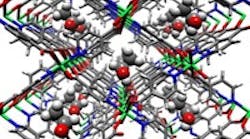Metal organic frameworks (MOFs) are garnering increasing interest for a variety of applications including for storing and separating gases (see, e.g., "Chemical Makers Think Small," "Adsorbent Eases Carbon Capture," "Hydrocarbon Separation Gets Easier," and "Process Speeds Up Enantiomer Separation"). The crystalline nanomaterials boast very high surface area, plus their structure can be tailored for specific services. However, producing MOFs on a commercial scale in a fast, economical and environmentally friendly way has posed challenges. Now, researchers at Queen's University, Belfast, U.K., have developed a manufacturing technique based on milling that reportedly achieves all three aims.
METAL ORGANIC FRAMEWORK
Figure 1. Milling approach enables making MOFs from precursors that aren't soluble. Source: MOF Technologies."Now, for the first time, our patented technology allows the synthesis of MOFs without using any solvents, even water, and on greatly reduced timescales, by making use of mechanochemistry," says Stuart James of the university's School of Chemistry and Chemical Engineering. "By simply grinding together two cheap precursors in a basic milling machine, the MOF material is produced in a matter of minutes, in a powder form, ready for applications without further treatment, and without generating solvent waste." The approach offers significant benefits even over techniques that only use water, adds Tom Robinson, CEO of MOF Technologies, Belfast, a spin-off company formed to make MOFs using the milling approach (www.moftechnologies.com). "Water is still a solvent and needs to be purified for reuse. It also needs to be removed from the pores of the MOFs after synthesis. Water-based synthesis can also only be achieved for a very narrow range of MOFs. Our process is very rapid compared with these solvent-based techniques and the process of activation and washing of the MOF after synthesis (to unlock the pores) is much simpler."MOF Technologies already has begun small-scale production and expects to ramp up manufacturing to commercial scale in a year, he notes.Start of initial trials at a number of end-users, for gas storage and separation applications, should be underway by the end of 2012, Robinson says. "…Tailoring of the material properties will be the next step after initial trials. We will look at different MOF structures as well as functionalization, for example through postsynthetic modification."If the trials meet expectations, the materials may gain industrial use within the next 12 months, he believes. The first commercial applications likely will be for separations. "The uniformity and tunability of the pore size and structure of these materials make them well suited to these applications. There are huge potential energy savings over distillation, for example," Robinson notes."A bed of MOF material can be used for adsorptive separations, for example in a pressure-swing adsorption process. Here, the selective adsorption of the material is the key property. However, they can also be used in membranes, where molecular sieving dominates. Here, the well-defined and tunable pore size/shape of MOFs is advantageous," he explains."As an example, acetylene/methane selectivities of more than 700 have been reported. Pore volume also is important. MOFs have higher pore volumes and, therefore, higher capacities than other solid adsorbents such as zeolites," Robinson adds.MOF Technologies expects to offer MOFs tuned for hydrocarbon separations within the next year. It plans to sell a general line of MOFs for such services as well as custom versions for particular end-users.While the firm will produce commercial quantities of the materials, it also is looking to license the technology for large-volume applications, he notes."We believe that mechanochemistry in general is a scalable, environmentally friendly platform technique that can replace solvent-based processes for the production of a wide range of materials," Robinson stresses.

